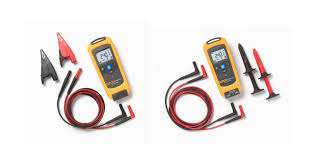 teddy@teddyele.com
teddy@teddyele.com +86 13968749891
+86 13968749891


 +86 13968749891
+86 13968749891

Jul 4,2025
Do you face hassle finding out whether a voltmeter or a multimeter would fulfill your need? If you are reading this blog, you must be a little aware of what both of these devices are. Nonetheless, it’s never too late to know everything about something. That is why we are here to guide you the best.
Moreover, if you are totally unaware of these devices, then you should read this guide and understand which one you need.
Knowing the difference between a voltmeter and a multimeter matters, especially for DIYers, electricians, and electronics hobbyists. However, this guide will compare functions, usage, price, accuracy, and practical applications of both these devices. You’ll know exactly which tool suits your needs by the end.
A voltmeter is a device that measures the electrical potential difference (voltage) between two points in a circuit. It is specifically crucial for measuring AC voltage in particular applications.
Voltmeters have two types: analog voltmeters and digital voltmeters. The difference between analog and digital voltmeters is simple. Analog voltmeters use a needle to show voltage. In comparison, digital voltmeters display the voltage in figures.
It is perfect for basic voltage checks in automotive, batteries, or small circuit diagnostics.
What are the Limitations of Voltmeter?
It cannot measure current or resistance.
A multi-functional tool that measures voltage, current (amps), resistance (ohms), and often continuity, capacitance, and more.
We have two types of multimeters: Analog multimeters and digital multimeters. Both these meters basically differ from each other for a reason. That reason is that both these devices show different numbers on the screen. Analog meters are typically more robust and don’t require batteries to function. In comparison, digital meters offer higher accuracy and additional features. Not only this, but their readability is easy. Discover the details about digital multimeter accuracy and precision in this comprehensive article.
It automatically chooses the suitable measurement range (current, voltage, existence, etc.). It is for the signal being measured.
The data hold function on a multimeter confines the displayed reading when you press its button. This is useful when the measurement value is quickly changing. Or, when you require a document for a particular reading. It enables you to catch and store a stable measurement, which can be helpful in several applications.
The temperature function in a multimeter enables it to measure temperature with the help of a thermocouple or temperature sensor. The multimeter reads the electrical signal from the sensor and translates it into a temperature reading, generally shown in Celsius or Fahrenheit.
The frequency function of a multimeter displays the number of times an AC signal repeats in just a second. This is known as frequency and is measured in Hertz (Hz).
Multimeters with this feature can be used to check the frequency of AC signals in circuits, wires, or other electronic items. This is to ensure that they are functioning correctly.
A multimeter is an adaptable tool used in residential wiring diagnostics for various purposes. Now, the question comes: what does it help? Well, it helps in measuring voltage, current, and resistance to identify issues. It also ensures safe electrical systems.
Multimeters are necessary tools in electronics repair. We use them to measure voltage, current, and resistance in circuits and other elements. They help evaluate issues, identify open or short circuits. Also, they check the working of electronic items.
A multimeter is an adaptable tool used in vehicle troubleshooting to measure voltage, current, and resistance within a vehicle’s electrical system. It helps identify problems. Those issues can be bad wiring, faulty connections, or failing elements. Understand the comparison of digital voltage meter vs analog voltage meters by reading this detailed blog and solve your issues on the go.
Voltmeter: Primarily measures voltage, the possible difference between multiple points in a circuit.
Multimeter: Measures more than one electrical parameter, including frequency, sometimes capacitance, resistance, current, and voltage.
• Measuring Battery Voltage: To evaluate whether a battery is completely charged or not.
• Testing Voltage at Outlets and Electrical Elements: To make sure proper power is available and identify possible problems.
• Solving Electrical Circuits: By measuring voltage at different points, you can figure out the core of the issue.
• Calibrating Other Electrical Devices: To ensure precision and dependency.
A multimeter is an adaptable tool used to measure several electrical elements. It can measure AC and DC voltage, AC and DC current, and continuity. Some modern multimeters can also measure temperature, capacitance, and other parameters. However, a multimeter is used in technical diagnostics and professional tasks.
• Connection: Aligned
• Purpose: Measures the difference in electrical potential between two points in a circuit.
• Resistance: High resistance (Ideally unlimited) to reduce its effect on the circuit’s current flow.
• Measurement: Reads the voltage across the elements or point being measured.
• Voltage: Aligned
• Current: Series
• Resistance: With the circuit power off
· Might only handle AC or DC.
· Mostly supports both, has the ability to switch between them.
· Typically, voltmeters can offer highly accurate voltage measurements.
· Analog voltmeters: ~±2–5%
Multimeter accuracy refers to how closely its readings match the real value of the measured electrical parameter. Digital parameters usually have better precision than analog multimeters.
Standard digital multimeters generally have an accuracy of ±0.5% on DC voltages. In comparison, analog multimeters might have a precision of ±2% or ±3% of full scale.
• Digital multimeters: ±0.5% or better; true-RMS options for accurate AC readings
Voltmeter: $10–$25
Basic Multimeter: $15–$50
Advanced Multimeter: $100–$300+
Voltmeter: Compact.
Multimeter: Slightly bulkier, but still portable.
Voltmeter: Basic safety, but limited to only voltage check.
Multimeter: Basic safety, but limited to voltage check.
|
Feature |
Voltmeter |
Multimeter |
|
Measures |
Voltage only |
Voltage, Current, Resistance, etc. |
|
AC/DC Compatibility |
Often limited |
Usually both |
|
Usage |
Basic checks |
Professional diagnostics |
|
Accuracy |
Moderate |
High (especially digital models) |
|
Cost |
Low |
Varies (basic to advanced) |
|
Portability |
High |
Moderate |
|
Circuit Use |
Parallel only |
Series & parallel (varies by mode) |
Multimeters are adaptable tools that offer various benefits and several applications. They can measure voltage, current, and resistance, making them necessary for solving electrical and electronic issues. Digital multimeters are specifically beneficial for their precision, convenience of use, and adaptability. Here are the benefits of multimeters:
Multimeters can measure more than one electrical quantity. They include frequency, capacitance, sometimes temperature, current, resistance, and voltage with just one tool.
Digital multimeters offer more precise measurements than analog meters, especially for precise measurements.
Digital multimeters are easy to read, with results shown directly in numeric values. Plus, they provide attributes such as auto-ranging and polarity detection.
This reduces the effect of the multimeter on the circuit being measured, leading to more precise readings.
Multimeters are used in several fields. They include electrical troubleshooting, vehicle diagnostics, home electrical work, industrial upkeep, and HVAC systems.
Many digital multimeters provide attributes such as data logging, which enables robust analysis of measurements over time.
Multimeters are mostly compact and portable, making them easy for several applications.
A multimeter is a very useful device. Nonetheless, it can be costly, sensitive to damage, and may not be appropriate for all applications. Digital multimeters tend to have battery problems, fluctuating readings, and are open to noise. Analog multimeters can be very convenient, but can cause complicated errors. Here we have explained each one of them in detail:
Digital multimeters can be costly, especially those with modern features and high precision, according to Testbook.
Digital multimeters are sensitive to heavyweights. However, any internal damage can be difficult to find and repair, as per GVDA.
Digital multimeters need a battery or other power source for their LCD display, which can be dim when the battery goes down, as per Polytechnic Hub.
Digital readings can fluctuate quickly and may take time to stabilize, making them difficult to read and possibly slowing down work in particular applications, as per Hioki.
Digital multimeters can be more susceptible to external noise than analog meters, as per Hioki.
Digital multimeters generally have low output voltages, which can make it difficult to check particular elements with particular voltage attributes, as per GVDA.
Range indications on digital multimeters can be difficult to see and grasp, as per Quora.
The precision of digital multimeters can rely on the frequency of the signal being measured, as per Quora.
Voltmeters offer several benefits, including precise voltage measurement, problem-solving capabilities, and the ability to verify circuit performance and ensure safe power usage. They are essential tools for diagnosing electrical problems, verifying battery health, and ensuring the proper functioning of various electrical components. Below are the benefits of a voltmeter:
Voltmeters offer highly accurate measurements of voltage, making them perfect for applications where precision is crucial.
They can identify bad connections, voltage drops, or other problems in electrical circuits.
Voltmeters ensure that circuits are functioning correctly, ensuring all components get the correct voltage for best performance.
By measuring voltage drop across all devices, voltmeters assist in optimizing power usage and preventing potential harm.
They can be used to measure the voltage of batteries, giving insights into their health and state of charge.
We can use voltmeters to calibrate other electrical instruments, ensuring the precision of measurement systems.
Voltmeters can be used to figure out issues such as short circuits, open circuits, and bad connections.
Voltmeters help ensure that appliances and other devices get the right voltage, preventing possible damage.
Follow this step-by-step process to use a digital voltmeter better:
The process begins when the DVM is connected across multiple points in a circuit where the voltage is required to be measured. This input voltage is an analog signal, meaning it depends on time.
There are chances that the input voltage can be extremely high or extremely low for the voltmeter’s inner circuitry to process directly. In such places, the signal goes by a signal conditioning stage where it is either minimized or extended. Nonetheless, it relies on the range of the input.
Once the voltage is within a suitable range, it travels to an Analog-to-Digital Converter (ADC). This is a major element of a digital voltmeter. The ADC samples the analog voltage at daily gaps and turns these samples into digital values, binary numbers that the microprocessor can grasp.
For precise conversion, the ADC requires a reference voltage, a stable, known voltage used as a comparison standard. The precision of the digital voltmeter hugely relies on the stability and precision of this reference.
The digital values generated by the ADC are then processed through a microcontroller or digital logic circuit. This processing may contain error correction, calibration, and formatting of the value for display.
Lastly, the processed voltage value is shown on the digital screen of the voltmeter. This display generally shows values with high accuracy, like “5.00 V” or “230.4 V”.
Enhanced digital voltmeters mostly contain various modern attributes:
• Auto-ranging, which automatically chooses the most suitable measurement range for the input voltage.
• Heavyweight protection. This protects the inner circuits if the input voltage is extremely high.
• Data hold, which enables users to confine the displayed value for easier reading.
• Multifunctionality, where it is possible for the device to measure current, resistance, and sometimes frequency or temperature. This is called a digital multimeter (DMM).
• Multifunctionality, where the device can also measure current, resistance, and sometimes frequency or temperature — this is known as a digital multimeter (DMM).
• Newbie’s Tip: Select a multimeter for the whole-day flexibility.
• Professionals: A Real RMS multimeter is given priority.
• Budget Users: A voltmeter suffices for simple battery and outlet tests.
• Safety: Always keep in mind to purchase devices with complete certifications (UL, CE)
Get Enough Knowledge about Your Instrument
Get enough knowledge about your meter’s/ current limits and all safety ratings. Get Acknowledged about Category Rating: Look for CAT 1, 2, 3, or 4 ratings. Higher categories such as CAT 3 or 4 are safer for industrial and high-energy environments.
Examine Leads: Look for cracks, damage, and exposed wires. Damaged leads can expose you to huge dangers of short circuits or electric shocks.
Verify Fuse Integrity: Use only producer-recommended fuses. A blown fuse disables protection and extends the risk of harm or injury.
Recheck the Dial: Always set the meter to the right function (voltage, current, resistance) and range before connecting it to a circuit.
Begin with the Extremely High Range: If unsure of the voltage, begin at the highest setting and then step down. This prevents overloading the meter.
Insert Leads into the Correct Jacks: For most voltage and resistance measurements, use the COM jacks.
Only use the 10A or 20A jack for high-current measurements.
This can harm the meter and hurt you. Ensure the circuit power is turned off and capacitors are discharged before testing resistance and continuity.
Use the current port and range for the current. Current measurement involves placing the meter in series with the circuit, which is risky as compared to voltage measurement.
Avoid using the current mode when there is no need, especially on live circuits.
Always be cautious and aware of what voltage you are dealing with. Avoid measuring voltages above the meter’s maximum rating, which could damage the meter and cause injury.
When working on circuits above 50V or in an industry, use insulated gloves, safety glasses, and rubber mats to reduce the risk of electric shock.
Accidents mostly happen due to doing two tasks at a time or distractions. Stay focused, especially when dealing with live circuits or switching probe positions.
This was the complete guide to voltmeters vs. multimeters. We have written down the differences between them. However, for quick and inexpensive voltage checks, use a voltmeter. For full diagnostics, flexibility, and long-term use, → Use a multimeter. Moreover, a good digital multimeter is often a better long-term investment. So, choose wisely. If you are looking to source digital voltmeter, then you can try our digital voltage meter manufacturer for better quality and ontime delivery.
Yes, most multimeters measure voltage just as accurately—and do much more.
Yes, a multimeter can work as a voltmeter.
It provides accurate readings for non-sinusoidal AC voltages, critical in modern electronics.
Voltmeters are simpler, but most beginners can rapidly learn a multimeter.
Yes—if the multimeter is CAT III rated or higher.
Typically, yes. They also offer features like data hold, backlighting, and auto-ranging.
No, a voltmeter only measures voltage, while a multimeter measures multiple electrical parameters, including voltage.
A multimeter offers more functionality, making it ideal for complete diagnostics beyond just measuring voltage.
Yes, a multimeter can function as a voltage tester and offers greater accuracy and versatility.